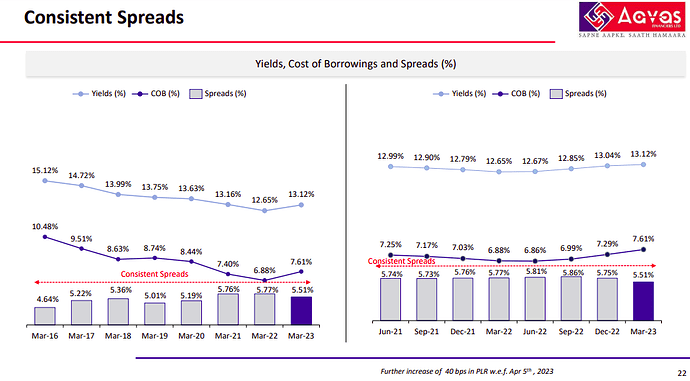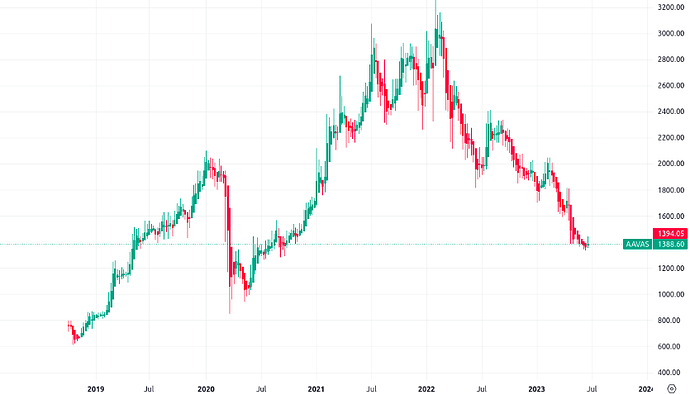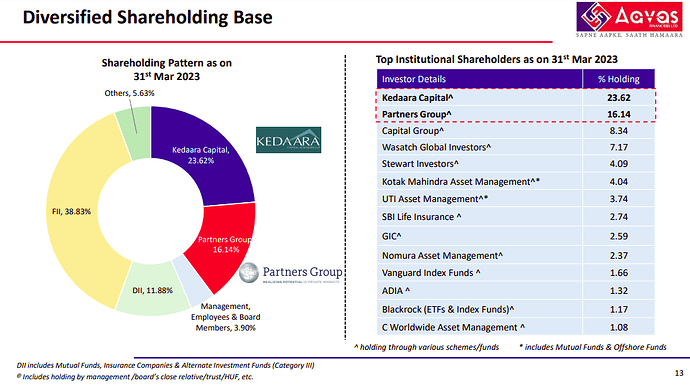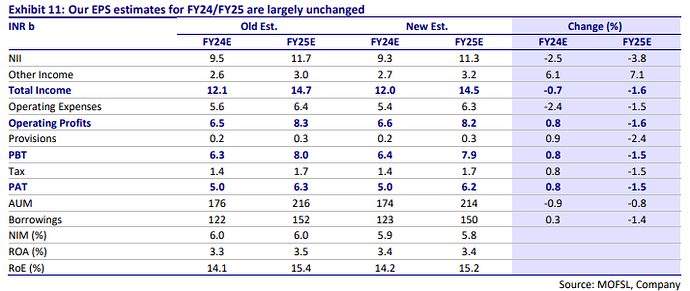A very generic answer, could you be more specific
Co. has been growing its AUM at 40%CAGR in the past years and now they are guiding for AUM growth of 20-25%CAGR going forward. The valuations that were given to the company was considering its 40% AUM growth and now that co. has guided for 20-25% AUM growth, market is adjusting its valuations accordingly.
It looks like Aavas is doing good fundamentally, but price has corrected a lot as compared to other stocks in the segment be it Aptus or Home First.
From 2018 till 2023, Aavas is showing healthy business growth AUM - 28% CAGR growth, PAT 36% CAGR
With Consistent Spreads and Cost of Borrowings are also not much affected by increase in interest rates.
With Price coming back to Apr 2019 levels.
There is increase in stake in FII holding
Big questions is, is the worst over with Aavas? or downtrend will continue with this stock? If private equity tries to dilute the stake from 24% where will it take this stock?
What was the BVPS and resultant PB at FY23 end?
What will be the 1yr fwd (FY24 end) BVPS and PB?
How does it compare to historical PB?
It is an excellent time to buy if it is below the historical average, near historical lows or -1 STDEV.
The PB de-rating has been due to the change in growth guidance. Might not make sense to compare it to historical PB in such a case.
Disc: Not invested.
Can you elaborate on the change of growth guidance?
In the earlier years, the growth guidance have been in the range of 30-40% YOY but now the guidance for the coming years, given by the management is 20-25%.
@nickajain It has been mentioned in the thread above
As far as I know, previous MD & CEO Sushilji has always guided for 20%+ AUM CAGR over a decade which he said he will be able to deliver. This is a good CAGR in any circumstance. Don’t think he ever said 30% CAGR.
Investment Thesis on Aavas Financier - July 14, 2023
AAVAS Financier
July 14, 2023
Company background
Aavas Financier is an affordable housing finance company (avg ticket size >10 Lakhs) with an impeccable record - 5-year CAGR of 27.22%… Reasons for growth have been steady expansion, deep understanding of borrowers (state-specific) and heavy investment in tech for all functions (evaluating credit worthiness, customer exp, collections etc). Technology investments enabled to bring down loans processing time (Turn Around Time) at a record 10 days, with a target of 3-4 days once technology changes are fully implemented (2024) while maintaining asset quality by containing gross NPAs at sub 1% throughout its life.
Investor presentation Q4 FY23
Moat: Ability to raise capital from diverse and cheap sources that are difficult to crack for competitors ( eg. world bank, long term bonds) so Cost of capital is 7.61% while making loans at 13.12% interest (passing on reduced cost of capital unlike peers). Most competitors raise funds at higher prices (eg using expensive short term NCDs or CPs)
Investor presentation Q4 FY23
Investor presentation Q4 FY23
Business model
Aavas started with home state Rajasthan lending to small salaried(40%) and self-employed (60%) people like govt. Employees, cab drivers, kirana store owner etc in T2, T3, T4 cities. It maintains its product mix of 70% housing loans and non-housing loans at 30% with a strong in-sourcing loans (no DSA) and strong legal, underwriting team. It expands prudently by launching in a state, deepening presence and then moving onto new one.
Since opex costs are high in T3-T5 cities and there are few customers meeting creditworthiness of banks, once penetrated competition in geographies is reduced from banks and other housing finance companies.
Size of opportunity
Access to credit is still extremely but from 2004 to now, percentage of house mortgages has only grown from 4-5% to 10-12% of GDP, while the same is 60-70% in developed markets
“Deepak Parekh : Mortgage-to-GDP ratio in India is 11%, compared to 18% in China and 52% in the United States”
Drivers of growth of affordable housing sector
- Long term:
- Rising urbanisation and people coming out of poverty
- Increased access to credit on back of UPI, Jan Dhan accounts and Aadhar
- Short Term
- Election Year
- Interest rate normalisation
Investment Thesis
Due to bluechip quality execution, Aavas has commanded a median PE of almost 60 since November 2018 when it was listed. Current PE is under 30 due to 2 reasons
- Resignation of Founder CEO - Mr Sushil Agarwal
- Promoters may trim stake
However, it was planned and new CEO Sachin Bhinder was working closely with outgoing CEO for 3 months and has been with Aavas for 3 years.
Moreover, in the May '2023 concall- “no major attrition is expected, despite the founder’s resignation. 71% of employees have been with the company for 3+ years. MD&CEO also clarified that promoters have not sold shares in last 2 years and do not intend sell any stake in the near term too.”
I believe this is a great opportunity to buy a growing company at relatively cheaper valuations given the growth rate.
Moreover, investments in tech will compound over time increasing the speed and size of loan book (following growth of Bajaj Finance).
Shareholding pattern (Investor presentation - Q4 FY23)
Recent Block deals
Anti-thesis
- Profitability and size (scale challenges): It has a loan book size of 1.4L cr, growing at 25% CAGR is going to get more and more difficult.
- RoA has been high using low Debt to Equity ratio (3-4) which reduces cost of borrowing, pushing up profitability. Therefore maintaining a high Price to Book multiple would be difficult.
- Borrowing cost is expected to rise in the next 2 quarters due to older contracts coming up for repricing and rate hikes globally.
- Repeat business is rare due to few products (MSME loans will be started soon) and people introduced to capital may turn to banks after building credit history (business transfer risk).
Story in Charts
Investor presentation Q4 FY23
25 May 2023 Motilal Oswal Report
Points of interest
-
It added 25 branches in Q4FY23 taking the total branch network to 346 as of Mar’23
-
Write-off is just Rs0.25bn in 2021-23’s disbursement of Rs220bn.
-
RoA 3.51%
-
High Profitability (ROA) must be taken considering low leverage (Debt to Equity)
-
ECL Provision 0.71% of AUM
Guidance:
May 2023 Concall guidance
- Company is guiding for a growth rate of 20%-25%, with deeper growth in existing geographies and moderated growth in new territories.
- Home loan and non-home loan mix is not different than in Q4 of last year, with a focus on MSME and LAP portfolio.
- Margins have come down slightly due to increased cost of borrowing and time required to pass on increased rates to new assets, but company is confident in maintaining 5%+ spread.
- The company plans to remain between 30-35% non-home loans and 70% home loans.
- 90% of branches break-even in the first 12 months
- Continue to open 30-35 branches every year and will add 2 more states in the next
2 years - Planning to cover entire country in the next 15-20 years
ICICI report Highlights
MARGINS
- Increased prime lending rate by 160bps during FY23 and further increase of
40bps with effect from Apr 05, 2023.
o This led to increase in tenure for roughly 90% of AUM.
o In case of a customer having rate of 12%, rate hike led to increase of
Rs500-1000 EMI per month.
o Average EMI per month is Rs12,000. For non-HL, the incremental lending
rate is 13-15%, and HL is 10.5% to 12%.
-
NHB borrowing was Rs30bn out of which Rs20bn are fixed rated and have a 7
years’ tenure with a borrowing rate of <5%. For bank borrowing, MCLR rate is reset every 6 months. One reset has already happened; it might come again for reset after 6 months. So there will be some impact on borrowing cost in next two quarters. -
Marginal decrease in spread during Q4FY23 due to funding cost increase and lag for rate pass. Overall basis, the company remains confident about maintaining spread of >5%. In competition terms, the company is not seeing much competition in geographies it is operating as home loan penetration is not more than 2-3%.
-
On the asset side, >50% of the assets gets repriced immediately because of floating nature. For fixed rated assets, rates get repriced after 3 years. However, there is perfect match with how it moves on the liability side as well. Interest rate hikes take time on the new business. PLR gets repriced immediately for floating contracts.
GROWTH
- Its model is to first enter the market, learning about the market and then grow in that market.
- New geographies just entered are Karnataka and UP. Every 2-3 years, company identifies new geographies to grow.
- In new states, strategy continues to be targeting Tier 3 and below cities with focus on self-construction product.
- In rural areas, branches are low opex model. Rs20-25k rent, 4-5 employees. Within 6 months, 90% of branches have break-even. Today most 1-year-old branches are giving RoE of >12% and 3 years old branches are giving >20% RoE.
Reports for further reading:
Investor Presentation May 3, 2023
Questions
- Why such a large decentralised underwriting team in spite of tech investments?
- What is the growth at state-level?
Correct, there is also a webinar Sushilji did with Marcellus where he said 20% compounding over 20-25 years will create massive wealth and we are in no hurry. That kind of conservative thinking is more than welcome whilst running a lending business.
Amazing analysis. Just one more point, which i think is missed
It is Asset Liability Mismatch . Aavas has Capital Adeq. Ratio of 47%, which is very healthy and also since the borrowing is in form of TL and NCDs, with maturity of Laiblities aligned with Assets ,there is NO ALM .
Even at the time of Liquidity Tightening , Aavas will be easily sailed through.
Thanks!
Yes, but due to valuations it is a stock best bought when interest rates go up (like Bajaj Finance). As the saying goes, “when USA sneezes, rest of the world catches a cold.” As others take sick leave, cos like #Aavas & #BajajFinance start working overtime.
Sept '23 results - Qtr Sales YoY 25.8 % Qtr Profit YoY 14.0 % . The company is continuing to deliver good results.
Invested, will be increasing my holding.
Relative low AUM growth rate compared to its historical growth rate. Drop in NIM. The company is losing its premium since peer companies still have a 30% AUM growth rate where Aavas guided 20-25%, in the past, they said 25% but they grew at a much higher rate, but now growth is < 25%
We need to give time to Aavas Housing. There are two challenges
A) New Management
B) Lack of systems in place (specifically IT system) , this is evident from the fact that Turnaround time is approx 10 days .
Both of these challenges are getting addressed.
What makes Aavas an elusive HFC , vis a vis it’s competitors is it’s Pan India presence and outstanding underwriting.
In fact, in the management call , Sachin sir has said that both the issues will get addressed.
Tech implementation would be completed by FY24 . This will make the complete functions seamless, this reducing the TAT. Company has engaged consultants of repute to solve this.
Guidance
A) Medium term -20 -25 %AUM growth and margin 5 percent plus.
B) LONG TERM DECADAL AUM -1LAC CR (Refer to Page 8 of Annual Report)
I am really very positive on Aavas .
Even though this company is for Affordable housing and for mortgaged based loans, do you still see risk from
- Bajaj Finance
- Jio Financial
Bajaj Finance is like Airtel, and Jio Financial is like, well Jio, and Aavas could become like other telecom players which went bust.
Company might not go bust, but we can see the huge P/E derating which has happened in the stock, even though it has been growing EPS consistently.
Any thoughts?
It’s not telecom industry. There are tonnes of home finance companies. AAVAS focuses on folks who may not have credit history and low ticket loans. But with stringent checks.
Based on the conference calls, looks like it’s losing market share. That’s why it went down. They have sales force of 3500 and doing two loans in a month of avg 12 lac loans. You can guess where the growth will be. Also their sanction to disbursement went down to 80%.
I’m not sure why that is significant.
The real question is the management claims they are a conservative lender. Is that a real reason or ploy to hide their inefficiencies, only time will tell.







